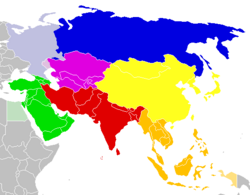Definitions

The region, together with part of South Asia, was well known by Europeans as the East Indies or simply the Indies until the 20th century. Chinese sources referred the region as "南洋" (Nanyang), which literally means the "Southern Ocean." The mainland section of Southeast Asia was referred to as Indochina by European geographers due to its location between China and the Indian subcontinent and its having cultural influences from both neighboring regions. In the 20th century, however, the term became more restricted to territories of the former French Indochina (Cambodia, Laos, and Vietnam). The maritime section of Southeast Asia is also known as the Malay Archipelago, a term derived from the European concept of a Malay race. Another term for Maritime Southeast Asia is Insulindia (Indian Islands), used to describe the region between Indochina and Australasia.
The term "Southeast Asia" was first used in 1839 by American pastor Howard Malcolm in his book Travels in South-Eastern Asia. Malcolm only included the Mainland section and excluded the Maritime section in his definition of Southeast Asia. The term was officially used in the midst of World War II by the Allies, through the formation of South East Asia Command (SEAC) in 1943. SEAC popularised the use of the term "Southeast Asia," although what constituted Southeast Asia was not fixed; for example, SEAC excluded the Philippines and a large part of Indonesia while including Ceylon. However, by the late 1970s, a roughly standard usage of the term "Southeast Asia" and the territories it encompasses had emerged. Although from a cultural or linguistic perspective the definitions of "Southeast Asia" may vary, the most common definitions nowadays include the area represented by the countries (sovereign states and dependent territories) listed below.
Ten of the eleven states of Southeast Asia are members of the Association of Southeast Asian Nations (ASEAN), while East Timor is an observer state. Papua New Guinea has stated that it might join ASEAN, and is currently an observer. Sovereignty issues exist over some territories in the South China Sea.
Political divisionsedit
Sovereign statesedit
| State | Area (km2) |
Population (2020) |
Density (/km2) |
GDP (nominal), USD (2020) |
GDP (PPP) per capita, Int$ (2020) |
HDI (2018 report) | Capital |
|---|---|---|---|---|---|---|---|
| 5,765 | 437,479 | 74 | 12,455,000,000 | $85,011 | 0.845 | Bandar Seri Begawan | |
| 181,035 | 16,718,965 | 90 | 26,730,000,000 | $5,044 | 0.581 | Phnom Penh | |
| 14,874 | 1,267,974 | 85 | 2,938,000,000 | $5,321 | 0.626 | Dili | |
| 1,904,569 | 267,670,543 | 141 | 1,111,713,000,000 | $14,841 | 0.707 | Jakarta | |
| 236,800 | 7,061,507 | 30 | 19,127,000,000 | $8,684 | 0.604 | Vientiane | |
| 329,847 | 31,528,033 | 96 | 365,303,000,000 | $34,567 | 0.804 | Kuala Lumpur * | |
| 676,578 | 53,708,320 | 79 | 65,994,000,000 | $7,220 | 0.578 | Nay Pyi Taw | |
| 300,000 | 106,651,394 | 356 | 356,814,000,000 | $10,094 | 0.712 | Manila | |
| 719.2 | 5,757,499 | 8,005 | 362,818,000,000 | $105,689 | 0.935 | Singapore | |
| 513,120 | 69,428,453 | 135 | 529,177,000,000 | $21,361 | 0.765 | Bangkok | |
| 331,210 | 95,545,962 | 288 | 261,637,000,000 | $8,677 | 0.693 | Hanoi |
Administrative subdivisionsedit
| Territory | Area (km2) | Population | Density (/km2) | GDP, USD (2018) |
GDP per capita, USD (2018) |
HDI (2014) | Capital |
|---|---|---|---|---|---|---|---|
| 8,251 | 380,600 | 46 | 0.778 | Port Blair* |
* Administrative centre in Putrajaya.
Dependent territoriesedit
| Territory | Area (km2) | Population | Density (/km2) | Capital |
|---|---|---|---|---|
| 135 | 1,402 | 10.4 | Flying Fish Cove | |
| 14 | 596 | 42.6 | West Island (Pulau Panjang) |
Geographical divisionsedit
Southeast Asia is geographically divided into two subregions, namely Mainland Southeast Asia (or Indochina) and Maritime Southeast Asia (or the similarly defined Malay Archipelago) (Javanese: Nusantara).
Mainland Southeast Asia includes:
Maritime Southeast Asia includes:
The Andaman and Nicobar Islands of India are geographically considered part of Maritime Southeast Asia. Eastern Bangladesh and Northeast India have strong cultural ties with Southeast Asia and are sometimes considered both South Asian and Southeast Asian. Sri Lanka has on some occasions been considered a part of Southeast Asia because of its cultural ties to mainland Southeast Asia. The rest of the island of New Guinea which is not part of Indonesia, namely, Papua New Guinea, is sometimes included, and so are Palau, Guam, and the Northern Mariana Islands, which were all part of the Spanish East Indies with strong cultural and linguistic ties to the region, specifically, the Philippines.
The eastern half of Indonesia and East Timor (east of the Wallace Line) are considered to be biogeographically part of Oceania (Wallacea) due to their distinctive faunal features. New Guinea and its surrounding islands are geologically considered as a part of the Australian continent, connected via the Sahul Shelf.
Comments
Post a Comment